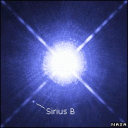



Sirius B is just 12,000km (7,500 miles) in diameter, similar to Earth, but its mass is 98% that of the Sun.
Studying Sirius B has been difficult because of the bright light coming from its neighbour, Sirius A, or the "Dog Star".
The results, published in the Monthly Notices of the Royal Astronomical Society, come from astronomers using the Hubble Space Telescope.
The international team used Hubble's imaging spectrograph to analyse light from Sirius B.
The mass calculations are based on how the star's light is distorted by its neighbour's intense gravitational field.
The gravitational field of Sirius B is about 350,000 times greater than the Earth's.
140
years of frustration
Professor Martin Barstow of Leicester University in the UK, who led the observing team, said they were delighted with the results.
"We're absolutely thrilled, after over 140 years of frustration, to finally get the information we need about this star so that we can work out whether our theory of white dwarfs is actually correct," he said.
Sirius B was discovered in 1862; but studying it in detail has proved difficult because of the intense light from Sirius A, the brightest star in the night sky.
"Only with Hubble have we at last been able to obtain the observations we need, uncontaminated by the light from Sirius, in order to measure its change in wavelengths," said Professor Barstow.
Determining the mass of white dwarfs is important to understanding the evolution of stars like our own Sun, which will become a white dwarf itself in about five billion years.
White dwarfs are stars which have run out of fuel for the nuclear fusion reactions which keep them burning.
Unable to generate heat and outward pressure, they collapse under their own gravitational field, but remain glowing until all the material in them has cooled.
January 9, 2006
MORE (The Sun)
BBC Science Correspondent

© 2005 BBC NEWS